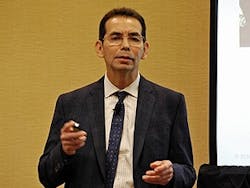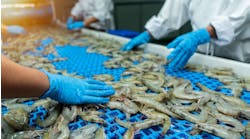“When Industry 4.0 came in, everybody learned about digitalization, but do they know about feedback control? Automation is everywhere, but nowhere to be seen.” Sigifredo Nino, Summa Control Solutions at Innovation Days 2019 in Austin, Texas
The first three industrial revolutions brought us the steam engine and feedback control (1.0); electricity, chemical synthesis and the proposal of proportional-integral-derivative, or PID, control (2.0); and the digital revolution with the transistor, personal computer and DCS with PID (3.0). “I call this PID 3.0,” said Sigifredo Nino, P. Eng., CEO and process control expert, Summa Control Solutions, in a presentation at this week’s Schneider Electric Innovation Days in Austin, Texas.
First defined at the 2011 Hannover Messe trade fair in Germany, the nine “foundational technologies of Industry 4.0” include additive manufacturing, cybersecurity and open systems, vertical and horizontal integration of systems, augmented reality, autonomous robots, the cloud, simulation, the Industrial Internet of Things (IIoT), and big data/analytics.
“So, where is control?” Nino asked. “Everywhere. We need more and more of it, but fewer and fewer people even know what it is. When Industry 4.0 came in, everybody learned about digitalization, but do they know about feedback control? Automation is everywhere, but nowhere to be seen.
“The real case is that there should be a synergy between the intelligence offered by automation professionals and the availability, visualization, integration and coordination of data offered by IIoT that leads to more extensive use and appreciation of people doing process control.”
Nino raised the case of a “President’s Award” competition that came down to a project that added a heat exchanger ($1 million cost, $1 million ROI) versus a high-purity distillation optimization that cost $70,000 and had an ROI of $2.5 million. The judges chose the heat exchanger project because the engineers didn’t explain the optimization project well enough.
“Control projects give ROI in days,” Nino said. Some think IIoT is a total solution, even for process control, but it’s just a tool, “and there’s nothing wrong with tools so long as they’re not a replacement for a lack of understanding of the process, but a way to augment our capabilities. Tools do not replace people.”
Control in the chemical industry
Consider why a new project needs instrumentation. The vast majority of the cost is for mechanical—pipes, pumps and vessels. Next comes electrical and finally, instrumentation. “It’s the smallest part, but it’s cut first,” Nino said.
Quoting process control guru Greg Shinskey, Nino said, “Virtually any arrangement of loops will operate satisfactorily in the steady state—it is the unsteady state that tests control performance.” The engineering and procurement contractor that builds the project wants to minimize capital expenditure (CapEx), and valves and instruments are expensive. “So, it puts in as few as possible,” Nino said.
But, the success of the control strategy depends on interactions and objectives that may only become clear after startup. Nino said, “This moves CapEx to operational expense, and you have to shut down the plant to fix it. It’s very expensive.”
Exploiting the DCS
It’s better to use the right level of equipment, and to use the fundamentals of control and the capabilities of the control system to minimize costs and increase performance. For example, a 500 MWe boiler converted from oil to gas was unstable. The solution demonstrated the advantage of the positional form of the PID algorithm, using predictive PID, mode scheduling, and feedforward.
“I wanted to change a PID block to a PID block with deadtime compensation, but with the plant running, there was no way to make the switch. Instead, I inserted a deadtime block into integral feedback of the PID block, configured as an interacting PID,” Nino explained. “It’s running today, and I haven’t visited the plant since 1999.”
At that time, “It had been running with no problem for a month so I told them, if something goes wrong, look at the final control elements, then the primary control elements,” Nino said. “Not the control strategy.”
To optimize the moisture control on a paper machine, the solution was PID optimum tuning. “With the original tuning, using well-known, no-good criteria, it took thousands of seconds to get back to setpoint” after a disturbance such as a change in water pH, and the machine would often shut down, Nino said. After tuning, that was reduced to a few hundred seconds. “The next day, the night supervisor told me, ‘I don’t know what you did to that controller, but I like it.”
In another case, a boiler that couldn’t be commissioned was fitted with excessive instrumentation and had overly complex control algorithms. Nino reduced the system to what was needed, and problems disappeared. “More sensors don’t mean more control,” Nino said. Sometimes, data analytics and machine learning can do more than additional instruments. Further, “Instruments, even if they’re getting cheaper, are not free, and there is additional complexity, maintenance and infrastructure associated with them.”
In summary, “There are no shortcuts, and no free lunch anywhere,” Nino said. “As Shinskey has said, ‘There is no substitute for process knowledge, and certainly none for common sense.’” Industry 4.0 is only bringing more automation, and people skilled in control will always be required.





